Use of Virtual Tools in Teaching-Learning Processes: Advancements and Future Direction
Abstract
1. Introduction
2. Referential Framework
Virtual Educational Tools
3. Methodology
3.1. Inclusion Criteria
3.2. Exclusion Criteria
3.3. Information Sources
3.4. Search Strategy
3.5. Data Management
3.6. Selection Process
4. Results
4.1. Quantity Indicators
4.2. Quality Indicators
4.3. Indicators of Structure
4.4. Trends
5. Discussion
6. Conclusions
Author Contributions
Funding
Data Availability Statement
Conflicts of Interest
References
- Akgül, Yakup, and Ali Osman Uymaz. 2022. Facebook/Meta usage in higher education: A deep learning-based dual-stage SEM-ANN analysis. Education and Information Technologies 27: 9821–55. [Google Scholar] [CrossRef] [PubMed]
- Alkhattabi, Mona. 2017. Augmented Reality as E-learning Tool in Primary Schools’ Education: Barriers to Teachers’ Adoption. International Journal of Emerging Technologies in Learning 12: 91–100. [Google Scholar] [CrossRef]
- Arango-López, Jeferson, Carlos C. Cerón Valdivieso, Cesar A. Collazos, Francisco Luis Gutiérrez Vela, and Fernando Moreira. 2019. CREANDO: Tool for creating pervasive games to increase the learning motivation in higher education students. Telematics and Informatics 38: 62–73. [Google Scholar] [CrossRef]
- Baltaci-Goktalay, Sehnaz, and Zehra Ozdilek. 2010. Pre-service teachers’ perceptions about web 2.0 technologies. Procedia-Social and Behavioral Sciences 2: 4737–41. [Google Scholar] [CrossRef]
- Biddau, Carlo, Alessandro Tel, Pier Paolo Brollo, Massimo Robiony, and Vittorio Bresadola. 2022. How to resume safe access to a medical simulation center at the time of COVID-19 pandemic: The proposal of a protocol from a university institution in North-Eastern Italy. Journal of Advances in Medical Education & Professionalism 10: 54–58. [Google Scholar] [CrossRef]
- Borgman, Christine L., and Jonathan Furner. 2002. Scholarly communication and bibliometrics. Annual Review of Information Science and Technology 36: 2–72. [Google Scholar] [CrossRef]
- Börner, Katy, Chaomei Chen, and Kevin W. Boyack. 2003. Visualizing knowledge domains. Annual Review of Information Science and Technology 37: 179–255. [Google Scholar] [CrossRef]
- Boumiza, Salma, Dalila Souilem, and Alexander Bekiarski. 2016. Workflow approach to design automatic tutor in e-learning environment. Paper presented at 2016 International Conference on Control, Decision and Information Technologies (CoDIT), Saint Julian’s, Malta, April 6–8; pp. 263–68. [Google Scholar]
- Boumiza, Salma, Alexander Bekiarski, Dalila Souilem, and Snejana Pleshkova. 2017. Development of model for automatic tutor in e-learning environment based on student reactions extraction using facial recognition. Paper presented at 15th International Conference on Electrical Machines, Drives and Power Systems (ELMA), Sofia, Bulgaria, June 1–3; pp. 488–92. [Google Scholar]
- Cabero-Almenara, Julio, María Arancibia, and Annachiara Del Prete. 2019. Technical and didactic knowledge of the moodle LMS in higher education. beyond functional use. Journal of New Approaches in Educational Research 8: 25–33. [Google Scholar] [CrossRef]
- Cano, Esteban Vázquez, María Luisa Sevillano García, and Javier Fombona Cadavieco. 2016. Análisis del uso educativo y social de los dispositivos digitales en el contexto universitario panhispánico. Revista de Investigación Educativa 34: 453–69. [Google Scholar] [CrossRef]
- Chavoshi, Amir, and Hodjat Hamidi. 2019. Social, individual, technological and pedagogical factors influencing mobile learning acceptance in higher education: A case from Iran. Telematics and Informatics 38: 133–65. [Google Scholar] [CrossRef]
- Cheng, Bo, Minhong Wang, Anders I. Mørch, Nian-Shing Chen, Kinshuk, and J. Michael Spector. 2014. Research on e-learning in the workplace 2000–2012: A bibliometric analysis of the literature. Educational Research Review 11: 56–72. [Google Scholar] [CrossRef]
- Cobo Romaní, Juan Cristóbal. 2009. El concepto de tecnologías de la información. Benchmarking sobre las definiciones de las TIC en la sociedad del conocimiento. Zer Revista de Estudios de Comunicación 14: 295–318. [Google Scholar]
- Comas Gonzalez, Zhoe Vanessa, Isabel Cristina Echeverri Ocampo, Ronald Zamora Musa, Jeimy Vélez, Roman Sarmiento, and Martha L. Orellana. 2017. Tendencias recientes de la Educación Virtual y su fuerte conexión con los Entornos Inmersivos. Revista Espacios 38: 1–14. [Google Scholar]
- De Fino, Mariella, Claudia Ceppi, and Fabio Fatiguso. 2020. Virtual tours and informational models for improving territorial attractiveness and the smart management of architec-tural heritage: The 3D-imp-act project. International Archives of the Photogrammetry, Remote Sensing & Spatial Information Sciences, 473–80. [Google Scholar]
- Dinis, Fábio Matoseiro, João Poças Martins, Bárbara Rangel Carvalho, and Ana Sofia Guimarães. 2018. Disseminating civil engineering through virtual reality: An immersive interface. Internationa Journal Online and Biomedical Engineering 14: 225–232. [Google Scholar] [CrossRef]
- Durán, Rodrigo, Christian Estay-Niculcar, and Humberto Álvarez. 2015. Adopción de buenas prácticas en la educación virtual en la educación superior. Aula Abierta 43: 77–86. [Google Scholar] [CrossRef]
- Durieux, Valérie, and Pierre Alain Gevenois. 2010. Bibliometric indicators: Quality measurements of scientific publication. Radiology 255: 342–51. [Google Scholar] [CrossRef]
- Elsevier. 2023a. Computers & Education. Available online: https://www.sciencedirect.com/journal/computers-and-education (accessed on 3 October 2022).
- Elsevier. 2023b. Computers in Human Behavior. Available online: https://journals.elsevier.com/computers-in-human-behavior (accessed on 3 October 2022).
- Enciso, Eliana María Villa, Jackeline Valencia Arias, and Alejandro Valencia Arias. 2016. El papel de las narrativas digitales como nueva estrategia educativa: Resultados desde un análisis bibliométrico. Kepes 13: 197–231. [Google Scholar] [CrossRef]
- Eshraghi, Arezoo, Noor Azuan Abu Osman, Hossein Gholizadeh, Sadeeq Ali, and Babak Shadgan. 2013. 100 top-cited scientific papers in limb prosthetics. Biomedical Engineering Online 12: 119. [Google Scholar] [CrossRef]
- Estarli, Mireia, Eliud S. Aguilar Barrera, Rodrigo Martínez-Rodríguez, Eduard Baladia, Samuel Duran Agüero, Saby Camacho, Kristian Buhring, Aitor Herrero-López, and Diana Gil-González. 2016. Ítems de referencia para publicar protocolos de revisiones sistemáticas y metaanálisis: Declaración PRISMA-P 2015. Revista Española De Nutrición Humana Y Dietética 20: 148–60. [Google Scholar] [CrossRef]
- European Conference on e-Learning. 2019. In Proceedings of 18th European Conference on E-Learning. Available online: https://www.academic-conferences.org/conferences/ecel/ (accessed on 11 December 2020).
- Fernández, Marianela Delgado, and Arlyne Solano González. 2011. Estrategias didácticas creativas en entornos virtuales para el aprendizaje. Actualidades Investigativas en Educación 9: 1–21. [Google Scholar] [CrossRef]
- Fombona, Javier, Ángeles Pascual-Sevillana, and MariCarmen González-Videgaray. 2017. M-learning and augmented reality: A review of the scientific literature on the WoS repository. Comunicar 25: 63–72. [Google Scholar] [CrossRef]
- Gläser, Jochen, Wolfgang Glänzel, and Andrea Scharnhorst. 2017. Same data—different results? Towards a comparative approach to the identification of thematic structures in science. Scientometrics 111: 981–98. [Google Scholar] [CrossRef]
- Gómez, Isabel, María Teresa Fernández, and Jesús Sebastián. 1999. Analysis of the structure of international scientific cooperation networks through bibliometric indicators. Scientometrics 44: 441–57. [Google Scholar] [CrossRef]
- Gupta, B. M., and Sujit Bhattacharya. 2004. A bibliometric approach towards mapping the dynamics of science and technology. DESIDOC Journal of Library & Information Technology 20: 3–8. [Google Scholar] [CrossRef]
- Hall, C. Michael. 2011. Publish and perish? Bibliometric analysis, journal ranking and the assessment of research quality in tourism. Tourism Management 32: 16–27. [Google Scholar] [CrossRef]
- Kaur, Avneet, and Munish Bhatia. 2021. Scientometric analysis of smart learning. IEEE Transactions on Engineering Management. [Google Scholar] [CrossRef]
- Komar, John, Jia Yi Chow, Masato Kawabata, and Corliss Zhi Yi Choo. 2022. Information and communication technology as an enabler for implementing nonlinear pedagogy in physical education: Effects on students’ exploration and motivation. The Asian Journal of Sport and Exercise Psychology 2: 44–49. [Google Scholar] [CrossRef]
- Krittanawong, Chayakrit, Mehmet Aydar, Hafeez Ul Hassan Virk, Anirudh Kumar, Scott Kaplin, Lucca Guimaraes, Zhen Wang, and Jonathan L. Halperin. 2022. Artificial intelligence-powered blockchains for cardiovascular medicine. Canadian Journal of Cardiology 38: 185–95. [Google Scholar] [CrossRef]
- Kumar Basak, Sujit, Marguerite Wotto, and Paul Belanger. 2018. E-learning, M-learning and D-learning: Conceptual definition and comparative analysis. E-learning and Digital Media 15: 191–216. [Google Scholar] [CrossRef]
- Lai, Jennifer WM, and Matt Bower. 2020. Evaluation of technology use in education: Findings from a critical analysis of systematic literature reviews. Journal of Computer Assisted Learning 36: 241–59. [Google Scholar] [CrossRef]
- Limniou, Maria, and Michael Smith. 2010. Teachers’ and students’ perspectives on teaching and learning through virtual learning environments. European Journal of Engineering Education 35: 645–53. [Google Scholar] [CrossRef]
- Liu, Yufei, V. E. Sathishkumar, and Adhiyaman Manickam. 2022. Augmented reality technology based on school physical education training. Computers and Electrical Engineering 99: 107807. [Google Scholar] [CrossRef]
- Makri, Katerina, Kyparisia Papanikolaou, and Athanasia Tsakiri. 2014. Blending the community of inquiry framework with learning by design: Towards a synthesis for blended learning in teacher training. Electronic Journal of e-Learning 12: 183–94. [Google Scholar]
- Martin, Sergio, Gabriel Diaz, Elio Sancristobal, Rosario Gil, Manuel Castro, and Juan Peire. 2011. New technology trends in education: Seven years of forecasts and convergence. Computers & Education 57: 1893–906. [Google Scholar] [CrossRef]
- Martin, Elisa M., Karen Myers, and Kirstiana Brickman. 2020. Self-preservation in the workplace: The importance of well-being for social work practitioners and field supervisors. Social Work 65: 74–81. [Google Scholar] [CrossRef]
- Mengual Andrés, Santiago, Esteban Vázquez Cano, and Eloy López Meneses. 2017. La productividad científica sobre MOOC: Aproximación bibliométrica 2012-2016 a través de SCOPUS. Revista Iberoamericana de Educación a Distancia 20: 39–58. [Google Scholar] [CrossRef]
- Ministerio de las Tecnologías de la Información y las Comunicaciones. 2020. ¿Qué son las TIC? En TIC Confío. Available online: https://www.enticconfio.gov.co/que-son-las-tic-significado (accessed on 1 December 2020).
- Norris, Michael, and Charles Oppenheim. 2007. Comparing alternatives to the Web of Science for coverage of the social sciences’ literature. Journal of Informetrics 1: 161–69. [Google Scholar] [CrossRef]
- O’cass, Aron, and Tino Fenech. 2003. Web retailing adoption: Exploring the nature of internet users Web retailing behaviour. Journal of Retailing and Consumer Services 10: 81–94. [Google Scholar] [CrossRef]
- Ozdilek, Zehra, and Sehnaz Baltaci-Goktalay. 2013. Pre-service science teachers’ perceptions about effective design of blended university chemistry courses. Turkish Online Journal of Distance Education 14: 165–80. [Google Scholar]
- Peciuliauskiene, Palmira, Giedre Tamoliune, and Elena Trepule. 2022. Exploring the roles of information search and information evaluation literacy and pre-service teachers’ ICT self-efficacy in teaching. International Journal of Educational Technology in Higher Education 19: 33. [Google Scholar] [CrossRef]
- Peña, Yasnalla Rivero, Jesús Rafael Hechavarría Hernández, and Maikel Leyva-Vázquez. 2018. Problem-based learning. An experience on the inclusion of quality problems in educational software engineering. In 2018 World Engineering Education Forum-Global Engineering Deans Council (WEEF-GEDC). Piscatev: Institute of Electrical and Electronics Engineers (IEEE), pp. 1–6. [Google Scholar] [CrossRef]
- Pięta, Hanna. 2017. Theoretical, methodological and terminological issues in researching indirect translation: A critical annotated bibliography. Translation Studies 10: 198–216. [Google Scholar] [CrossRef]
- Prieto, José Carlos Sánchez, Susana Olmos Migueláñez, and Francisco J. García-Peñalvo. 2014. Mobile learning adoption from informal into formal: An extended TAM model to measure mobile acceptance among teachers. Paper presented at Second International Conference on Technological Ecosystems for Enhancing Multiculturality, Salamanca, Spain, October 1–3; pp. 595–602. [Google Scholar]
- Prieto, José Carlos Sánchez, Susana Olmos Migueláñez, and Francisco J. García-Peñalvo. 2015. Behavioral intention of use of mobile technologies among pre-service teachers: Implementation of a technology adoption model based on TAM with the constructs of compatibility and resistance to change. Paper presented at 2015 International Symposium on Computers in Education (SIIE), Setubal, Portugal, November 25–27; pp. 120–25. [Google Scholar]
- Rodrigues Espinosa, Holmes, Restrepo Betancur, Luis Fernando, and Diego Aranzazu. 2014. Alfabetización informática y uso de sistemas de gestión del aprendizaje (LMS) en la docencia universitaria. Revista de la Educación Superior 43: 139–59. [Google Scholar] [CrossRef]
- Salinas, Jesús. 2005. La gestión de los entornos virtuales de formación. Paper presented at Proceedings of Seminario Internacional: La calidad de la Formación en Red en el Espacio Europeo de Educación Superior, Tarragona, Spain, September 19–22; pp. 1–21. [Google Scholar]
- Sánchez-Cabrero, Roberto, Amaya Arigita-García, Amelia Barrientos-Fernández, and Ana C. León-Mejía. 2019a. Online explorative study on the learning uses of virtual reality among early adopters. JoVE (Journal of Visualized Experiments) 153: e60188. [Google Scholar] [CrossRef]
- Sanchez-Cabrero, Roberto, Oscar Costa-Roman, Francisco Javier Pericacho-Gómez, Miguel Angel Novillo-Lopez, Amaya Arigita-García, and Amelia Barrientos-Fernandez. 2019b. Early virtual reality adopters in Spain: Sociodemographic profile and interest in the use of virtual reality as a learning tool. Heliyon 5: e01338. [Google Scholar] [CrossRef]
- Sánchez-Prieto, José Carlos, Susana Olmos-Migueláñez, and Francisco J. García-Peñalvo. 2016. Informal tools in formal contexts: Development of a model to assess the acceptance of mobile technologies among teachers. Computers in Human Behavior 55: 519–28. [Google Scholar] [CrossRef]
- Sánchez-Prieto, José Carlos, Ángel Hernández-García, Francisco J. García-Peñalvo, Julián Chaparro-Peláez, and Susana Olmos-Migueláñez. 2019. Break the walls! Second-order barriers and the acceptance of mLearning by first-year pre-service teachers. Computers in Human Behavior 95: 158–67. [Google Scholar] [CrossRef]
- Sancho, Rosa. 1990. Indicadores bibliométricos utilizados en la evaluación de la ciencia y la tecnología. Revisión bibliográfica. Revista española de documentación científica 13: 842–65. [Google Scholar] [CrossRef]
- Scholar. 2023. Francisco josé garcía-peñalvo. Available online: https://bit.ly/2KcfejO (accessed on 14 October 2022).
- Springer. 2023a. Lecture Notes in Computer Science. Available online: https://www.springer.com/series/558 (accessed on 3 October 2022).
- Springer. 2023b. Advances in Intelligent Systems and Computing. Available online: https://www.springer.com/series/11156 (accessed on 3 October 2022).
- Springer. 2023c. Communications in Computer and Information Science. Available online: https://www.springer.com/series/7899 (accessed on 3 October 2022).
- Universidad de Salamanca. 2023. Francisco josé garcía-peñalvo. Available online: https://grial.usal.es/fgarcia (accessed on 14 October 2022).
- Usuga-Escobar, Junnier Felipe, Luis Guillermo Palacio-Baena, and Dursun Barrios. 2022. Aceptación tecnológica de una aplicación móvil para la gestión de negocios lecheros. Revista CEA 8: e2007. [Google Scholar] [CrossRef]
- Valencia, Eduardo Menjivar, Enrique Sánchez Rivas, Julio Ruíz Palmero, and Teresa Linde Valenzuela. 2021. Revisión de la producción científica sobre la realidad virtual entre 2016 y 2020 a través de Scopus y WoS A review of the research literature published through the Scopus and WoS databases regarding virtual reality in the period between 2016 and 2020. EDMETIC 10: 26–55. [Google Scholar] [CrossRef]
- Valencia-Arias, Alejandro, Salim Chalela-Naffah, and Jonathan Bermúdez-Hernández. 2019. A proposed model of e-learning tools acceptance among university students in developing countries. Education and Information Technologies 24: 1057–71. [Google Scholar] [CrossRef]
- Vander Valk, Frank. 2008. Identity, power, and representation in virtual environments. MERLOT Journal of Online Learning and Teaching 4: 205–11. [Google Scholar]
- Villa, Eliana, Luis Ruiz, Alejandro Valencia, and Edgar Picón. 2018. Electronic commerce: Factors involved in its adoption from a bibliometric analysis. Journal of Theoretical and Applied Electronic Commerce Research 13: 39–70. [Google Scholar] [CrossRef]
- Zalavra, Eleni, and Kyparisia Papanikolaou. 2018. Supporting the learning design process: Insights into pre-service teachers. Paper presented at ECEL 2018: 17th European Conference on Elearning, Athens, Greece, November 1–2; pp. 620–29. [Google Scholar]
- Zancanaro, Airton, José Leomar Todesco, and Fernando Ramos. 2015. A bibliometric mapping of open educational resources. International Review of Research in Open and Distributed Learning 16: 1–23. [Google Scholar] [CrossRef]
- Zhang, Yi, Alan L. Porter, Denise Chiavetta, Nils C. Newman, and Ying Guo. 2019. Forecasting technical emergence: An introduction. Technological Forecasting and Social Change 146: 1–4. [Google Scholar] [CrossRef]
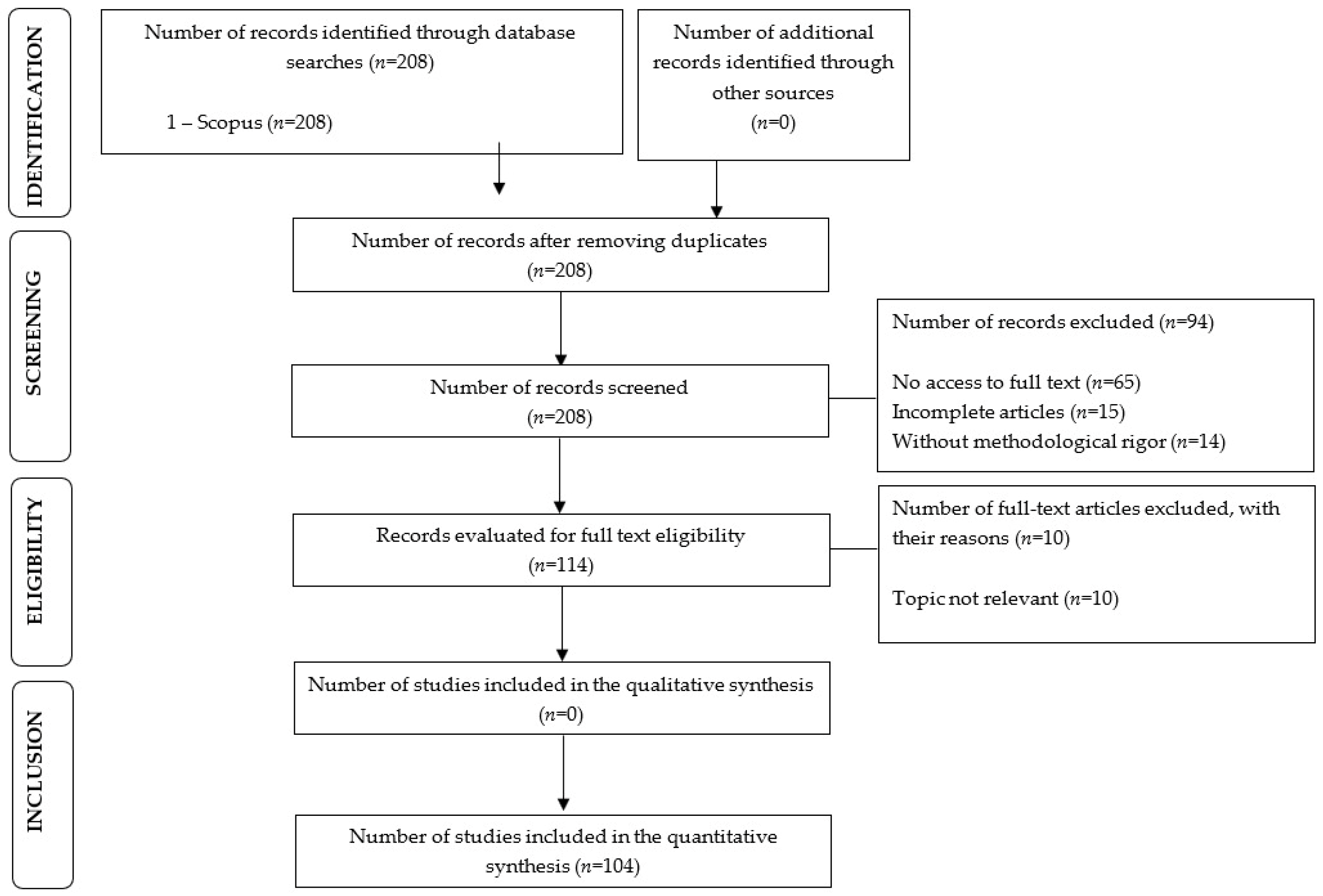
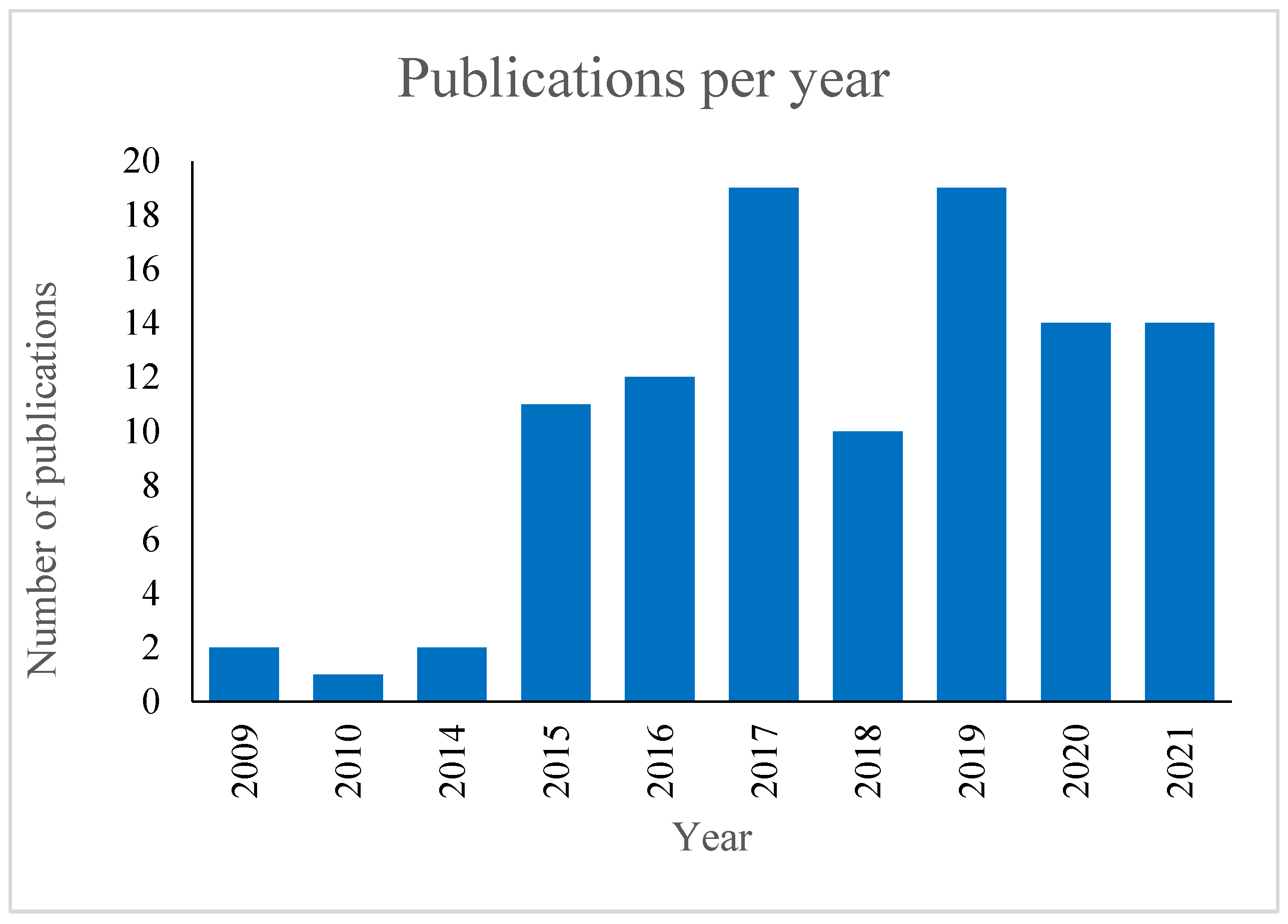

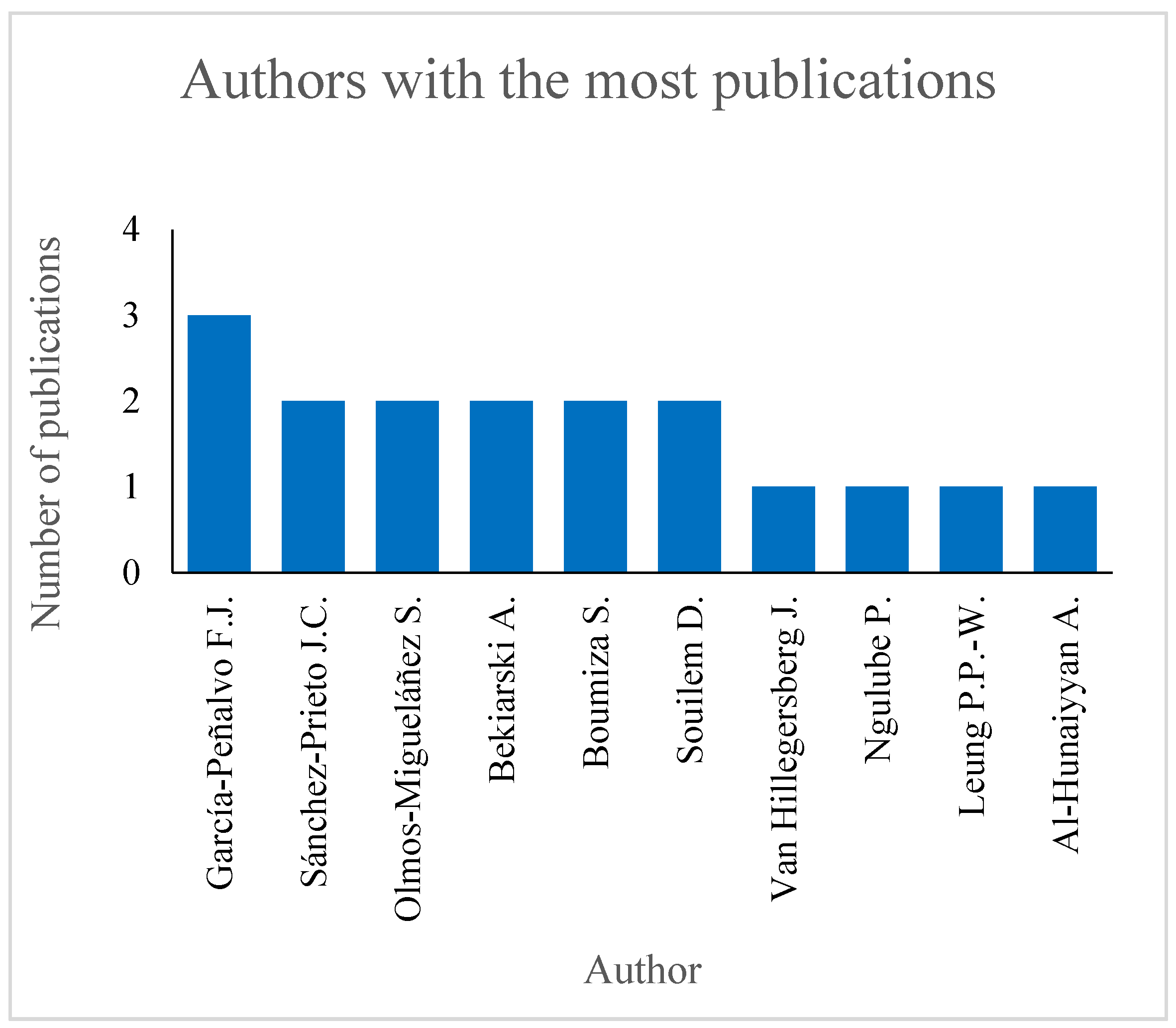
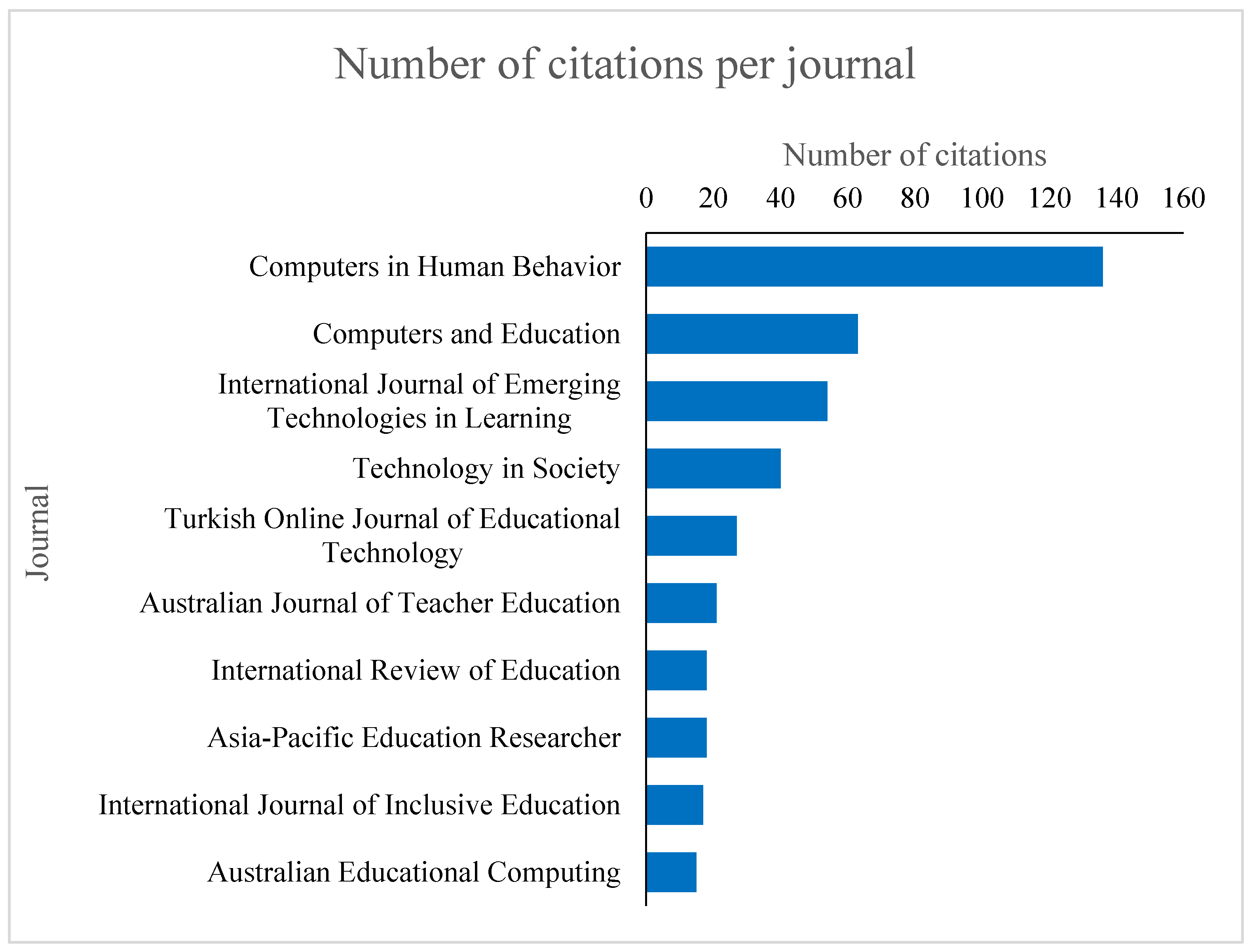
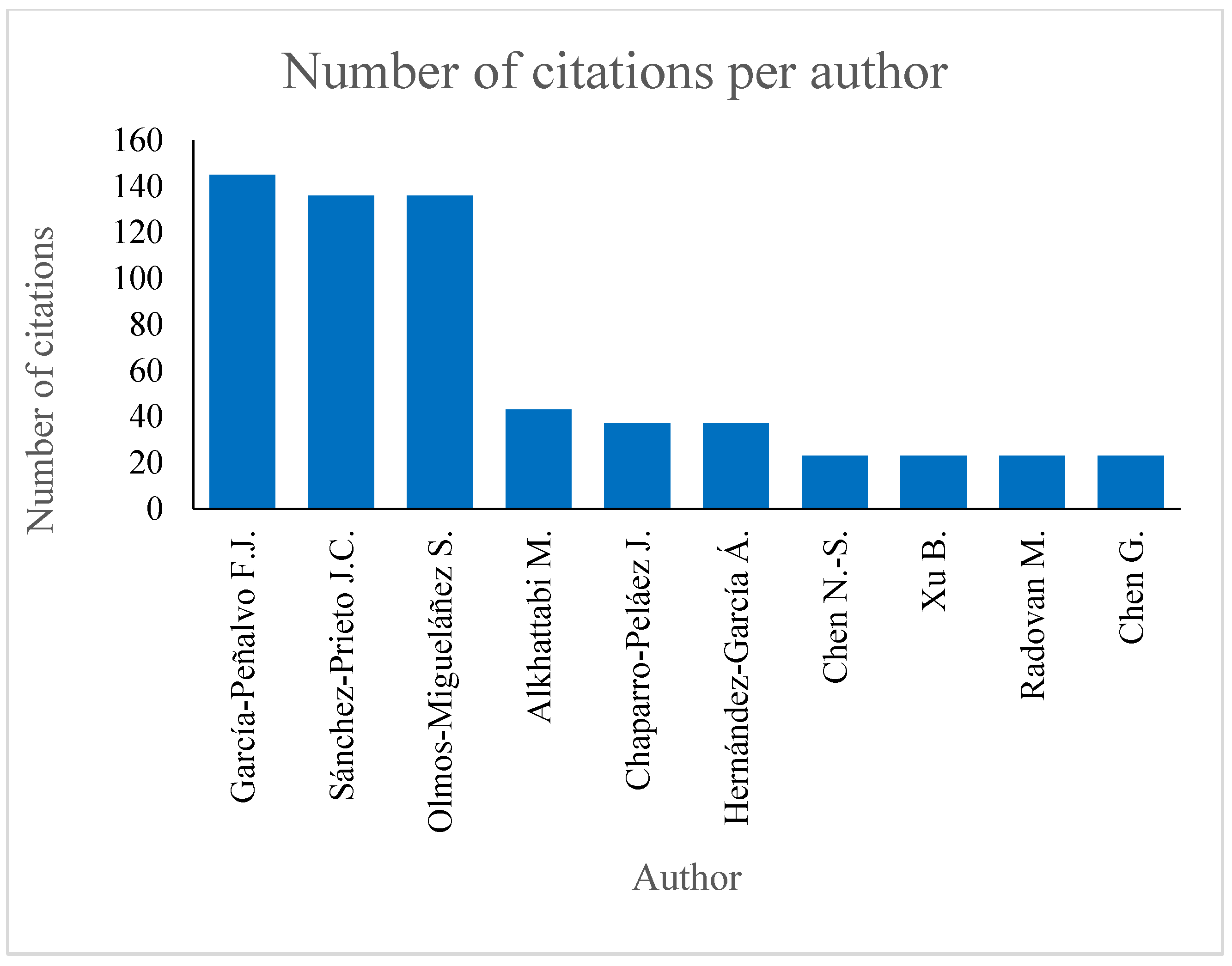
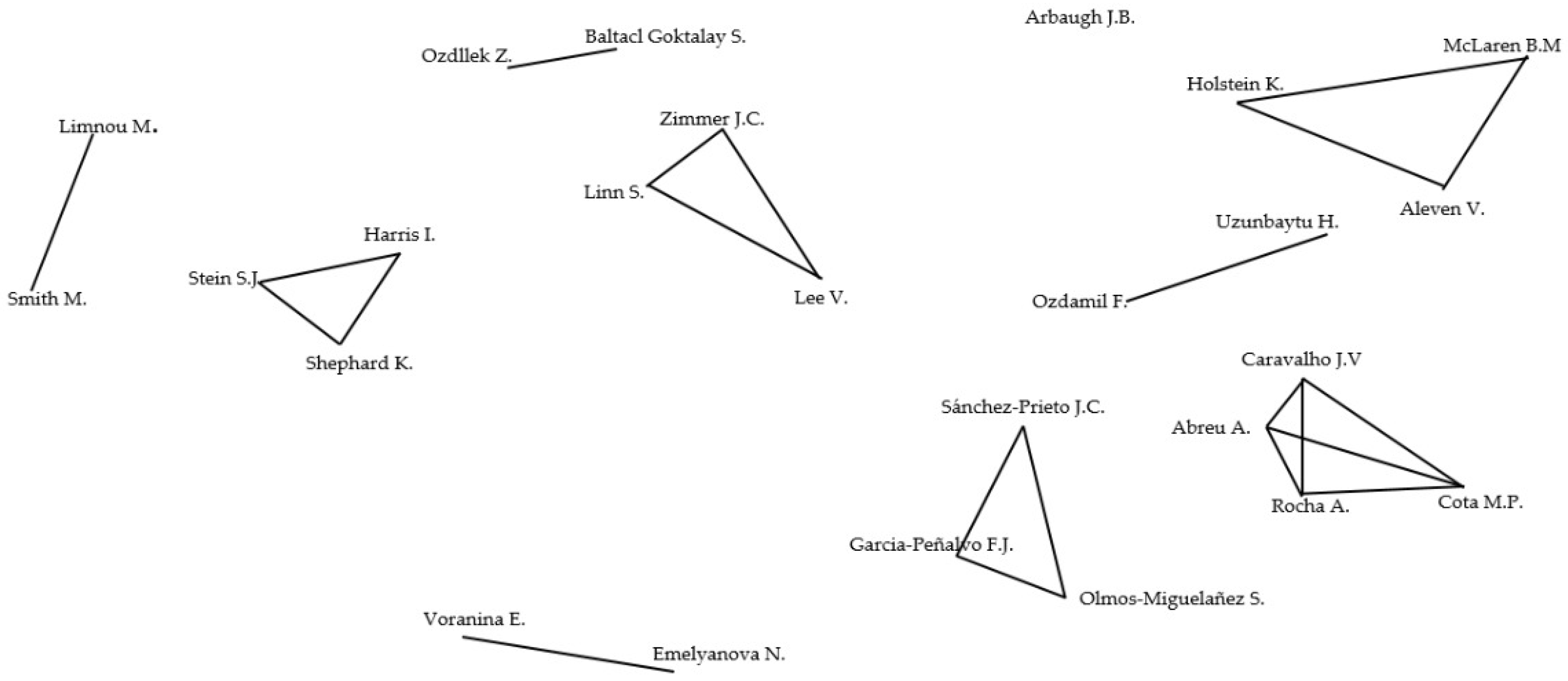
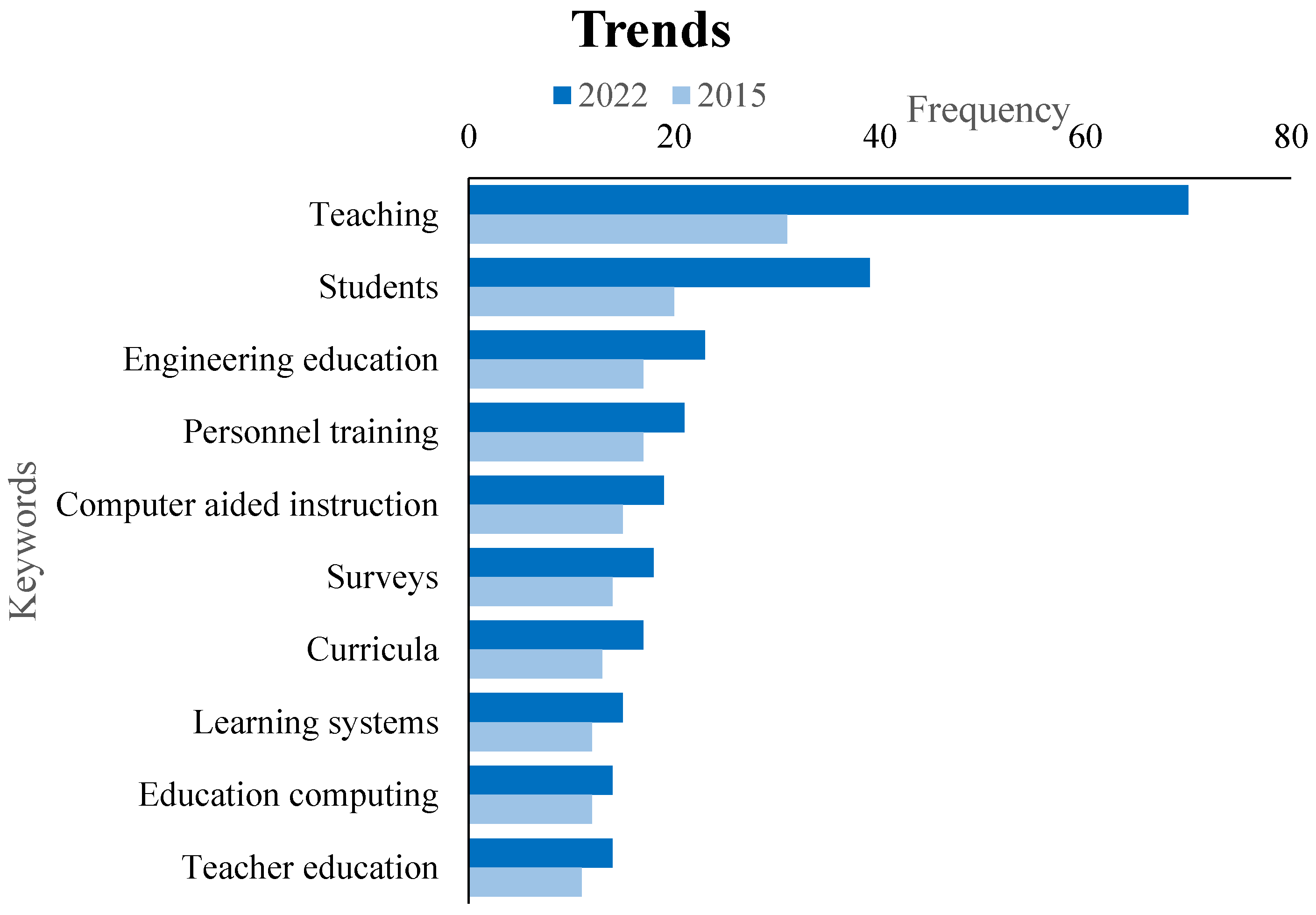
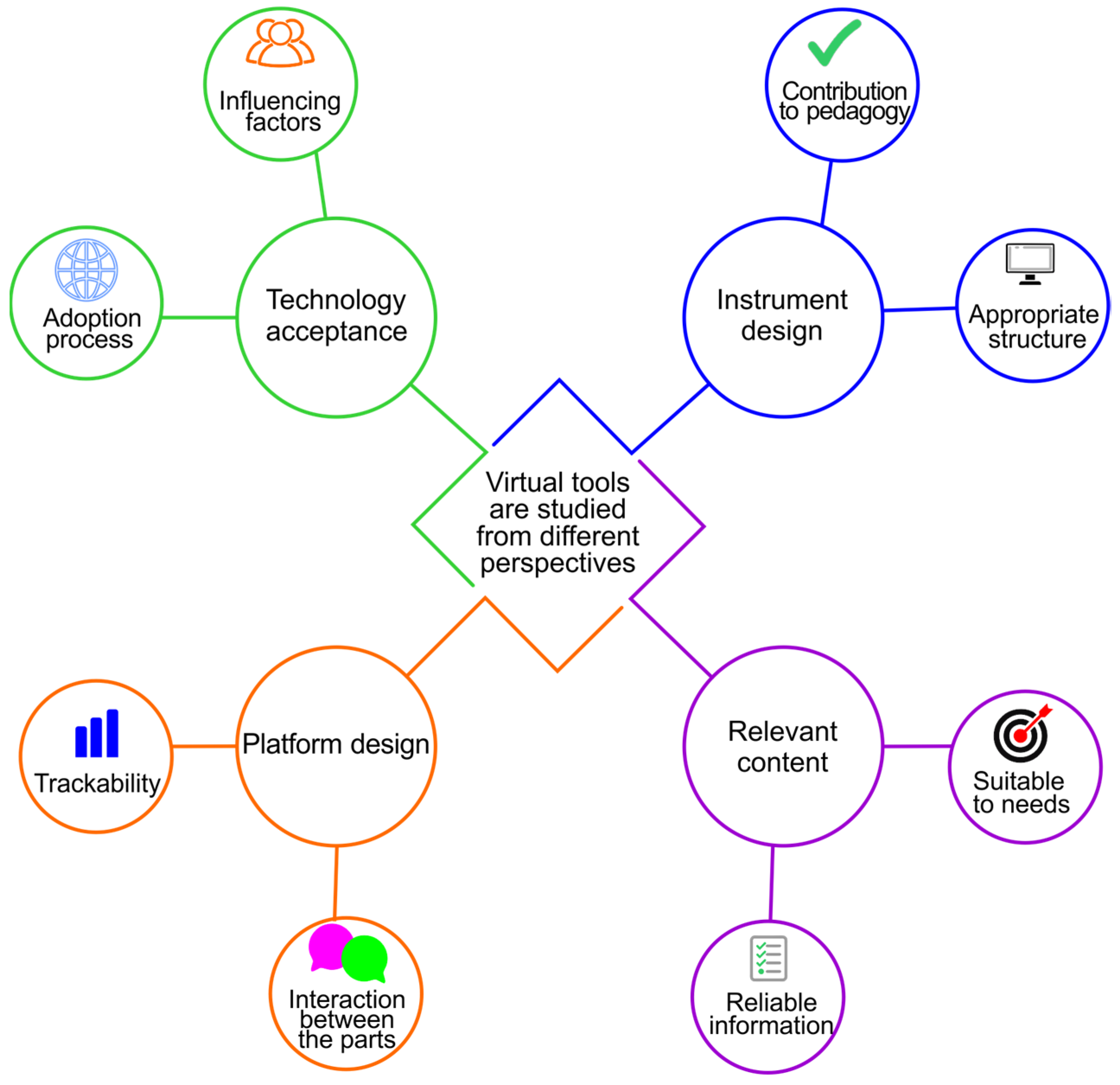
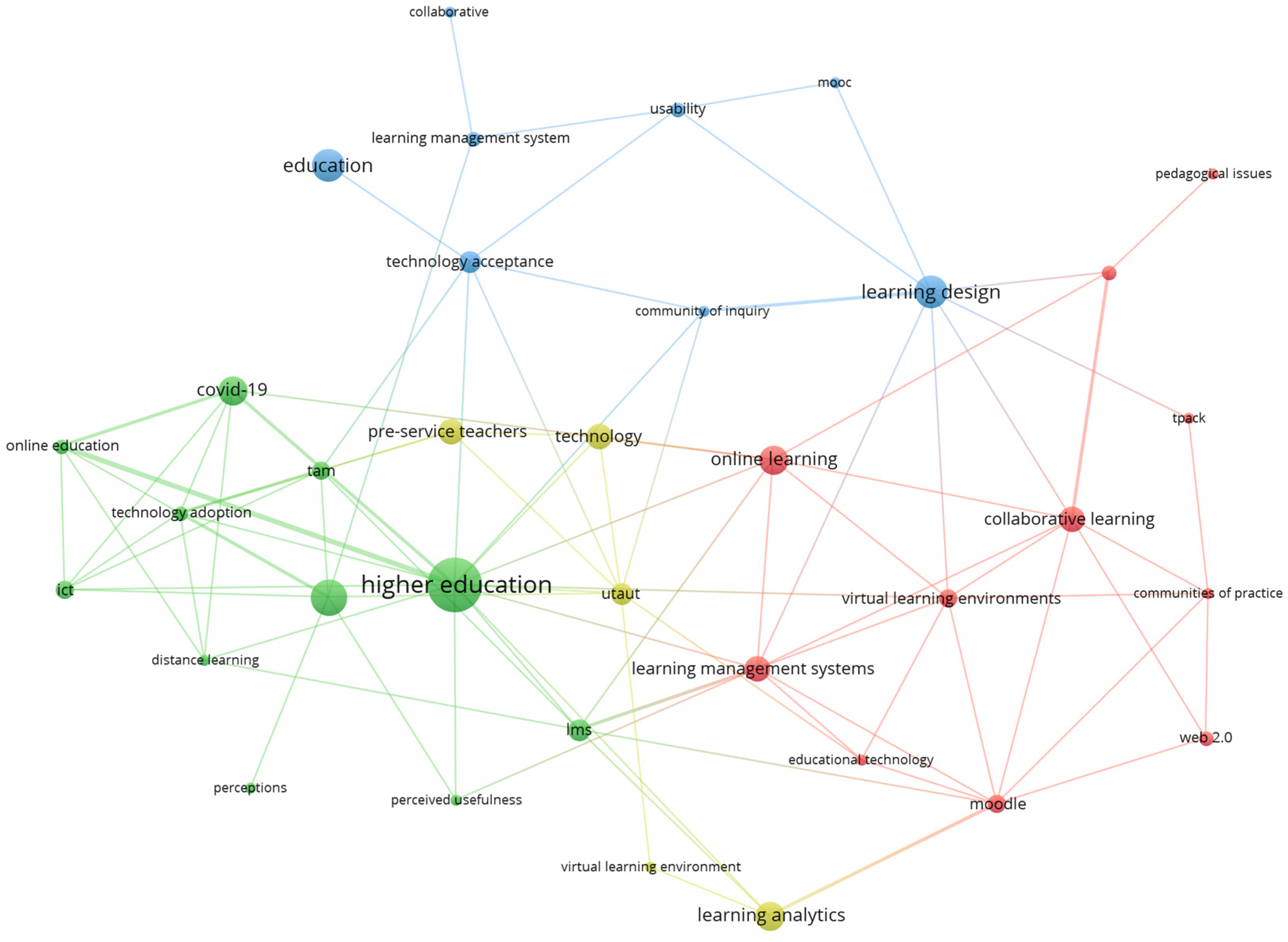
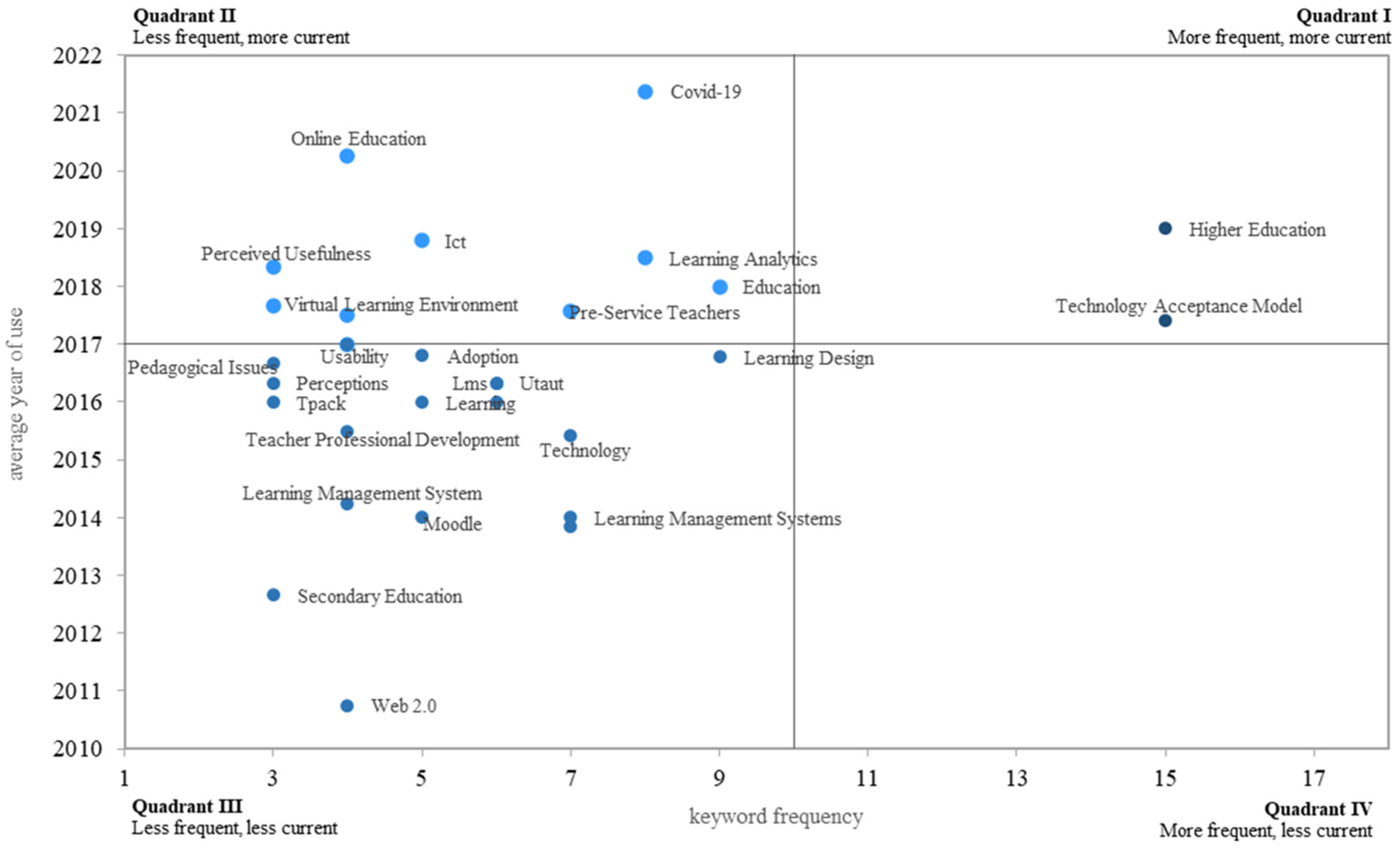
| Author | Research Area | Topic Covered in the Article | Reference |
|---|---|---|---|
| García-Peñalvo F.J. | E-learning, software engineering, web 2.0 and technological ecosystems | Factors involved in the adoption of mobile technologies in academic environments | (Sánchez-Prieto et al. 2019) |
| Sánchez-Prieto J.C. | Education, M-learning, technological acceptance | ||
| Olmos-Migueláñez S. | Education | ||
| Alkhattabi M. | E-learning, market intelligence, data mining. | Importance of the application of augmented reality in training | (Alkhattabi 2017) |
| Chaparro-Peláez J. | Information systems, electronic commerce, E-learning, learning analysis, technological acceptance | Factors involved in the adoption of mobile technologies in academic environments | (Sánchez-Prieto et al. 2019) |
| Hernández-García A | Information systems, digital transformation, digital marketing, learning analysis, technological acceptance |
Disclaimer/Publisher’s Note: The statements, opinions and data contained in all publications are solely those of the individual author(s) and contributor(s) and not of MDPI and/or the editor(s). MDPI and/or the editor(s) disclaim responsibility for any injury to people or property resulting from any ideas, methods, instructions or products referred to in the content. |
© 2023 by the authors. Licensee MDPI, Basel, Switzerland. This article is an open access article distributed under the terms and conditions of the Creative Commons Attribution (CC BY) license (https://creativecommons.org/licenses/by/4.0/).
Share and Cite
Botero-Gómez, V.; Ruiz-Herrera, L.G.; Valencia-Arias, A.; Romero Díaz, A.; Vives Garnique, J.C. Use of Virtual Tools in Teaching-Learning Processes: Advancements and Future Direction. Soc. Sci. 2023, 12, 70. https://doi.org/10.3390/socsci12020070
Botero-Gómez V, Ruiz-Herrera LG, Valencia-Arias A, Romero Díaz A, Vives Garnique JC. Use of Virtual Tools in Teaching-Learning Processes: Advancements and Future Direction. Social Sciences. 2023; 12(2):70. https://doi.org/10.3390/socsci12020070
Chicago/Turabian StyleBotero-Gómez, Vanessa, Luis Germán Ruiz-Herrera, Alejandro Valencia-Arias, Alejandra Romero Díaz, and Juan Carlos Vives Garnique. 2023. "Use of Virtual Tools in Teaching-Learning Processes: Advancements and Future Direction" Social Sciences 12, no. 2: 70. https://doi.org/10.3390/socsci12020070
APA StyleBotero-Gómez, V., Ruiz-Herrera, L. G., Valencia-Arias, A., Romero Díaz, A., & Vives Garnique, J. C. (2023). Use of Virtual Tools in Teaching-Learning Processes: Advancements and Future Direction. Social Sciences, 12(2), 70. https://doi.org/10.3390/socsci12020070







